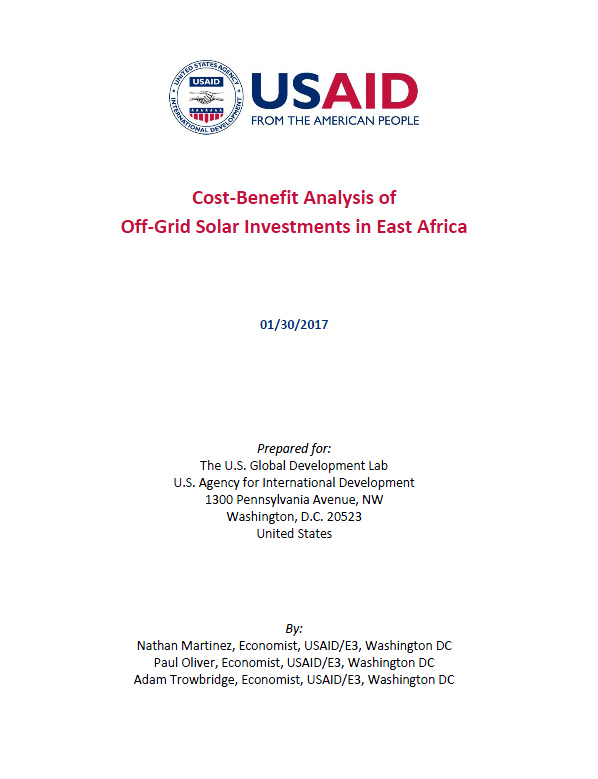- Energy Home
- How We Work
- Programs & Initiatives
- EmPOWERing Women and Girls
- Competitive Energy Procurement
- Toolkits
- Monitoring & Evaluation
- Resources
- Cost-Benefit Analysis of Off-Grid Solar
- DPV Impact on Utility Revenues and Electricity Tariffs
- Gender Equality in Renewable Energy
- Guide to Promoting an Energy Efficient Public Sector (PePS)
- Mobilizing Finance and Investment for Clean Energy
- Performance-Based Management Contracts
- Promoting Solar Energy in Haiti
- Scaling Up Energy Efficiency in Developing Countries
- Self-Reliance Through Electricity System Loss Reduction
- Stories
Speeches Shim
A cost-benefit analysis by USAID economists of four off-grid solar energy investments, representing $8.4 million in development assistance, determines the value for money of USAID’s investment by measuring the financial and economic cost of production and distribution, as well as impact on households.
An initial review of the results suggests USAID’s $8.4 million investment is creating over $17 million in net present value to the East African countries of Rwanda, Tanzania and Uganda. A majority of this value addition comes in the form of consumer surplus estimates, as households are spending less of their income on energy sources while enjoying additional hours of higher-quality lighting. At the same time, solar households continue to use large amounts of non-solar energy sources to meet their overall lighting needs. Many of the secondary impacts of supporting businesses to test new innovations and distribution approaches have not been captured in this analysis due to the difficulty of identifying attribution. This suggests the real value of these investments could be even greater than reported here.
Assuming an average product life of five years, results from the solar PV system analysis suggest that the ownership of each of the solar products causes a positive financial net present value (NPV) at the household level, meaning customers are experiencing a net increase in their incomes due to lower expenditures tied to annual lighting costs. The range of household benefits depends on the customer’s payment plan. Households participating in a pay-as-you-go plan (where customers pay for the solar systems in monthly installments over a 12 to 36-month period) experience a net financial gain ranging from $50 to $137, while households paying the full upfront cost at a 15 to 25 percent discount experience a net financial gain ranging from $53 to $117. Households purchasing smaller solar lanterns also experience net positive financial returns of around $45.
Each of the private companies funded by these investments supported different aspects of the supply chain, allowing for the evaluation of separate approaches to delivering solar products ranging from solar lanterns to PV home systems. Although there are positive economic gains associated with each of these solar investments, more work needs to be done to find financially viable distribution systems, in particular for less expensive solar products targeting low-income households. The primary constraints are the excessive cost of product distribution, high default rates among pay-as-you-go customers, and a breakdown in partnerships among different actors along the supply chain. The profitability of these companies is also under threat from a proposed policy change to remove an East Africa Community (EAC) tariff exemption, as this move would raise consumer costs, trigger a greater number of product defaults for pay-as-you-go customers, and drive a large number of competitors out of the market.
The makeup of East Africa’s solar industry is also constantly evolving and being driven by market innovations, expanding distribution systems, and sophisticated product targeting. Understanding the income distribution of households is critical to understanding the off-grid solar market. The segment of the population that can afford solar but is not yet connected to the grid is smaller than most people assume. In Rwanda, for example, an estimated 70 percent of households cannot afford to spend $1.50 per week for both lighting and phone charging.
Realizing these customer dynamics, actors in the East African solar energy market have begun to differentiate themselves by targeting higher income groups with more aspirational products like solar televisions. This move is rational for private businesses operating on thin profit margins as their goal is to earn a respectable return for their shareholders. Development partners, however, should decide if investments in this arena are targeting income groups that are aligned with their social and economic mission before determining where best to place public funds.
This analysis of development assistance provided through USAID’s Development Innovation Ventures (DIV) was conducted by economists from USAID’s Office of Economic Policy for the U.S. Global Development Lab.


Comment
Make a general inquiry or suggest an improvement.